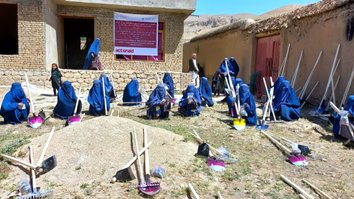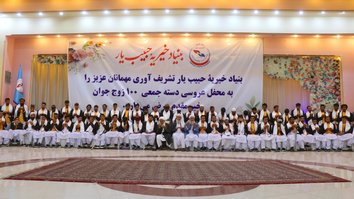KABUL -- The World Food Programme (WFP) has been implementing dozens of projects aimed at supporting Afghan women, including one that provided critical agricultural tools to help them feed their families and gain some income.
Some 98% of female heads of household in Afghanistan are currently facing food shortages, according to the WFP.
"Women and girls are extremely vulnerable and disproportionally impacted by violence or the effect of the economic crash," Philippe Kropf, spokesman for the WFP in Afghanistan, told Salaam Times.
"Women's education and livelihood opportunities have diminished, and food insecurity is putting women at disproportionate risk of malnutrition due to their unique nutritional needs during pregnancy, breastfeeding and adolescence," he said.
To help vulnerable Afghan women and girls, the WFP has implemented projects in 27 provinces in support of vulnerable communities, especially women and farmers, Kropf said.
One such project has helped female farmers use their backyard space to grow food -- not only for their household consumption but also as a source of income, he said.
The WFP and an NGO partner, Sustainable Agricultural and Rural Community Development Organisation (SARCDO), "distributed 35 fruit and vegetable solar dryers for 20 women in Laghman province and 15 women in Nangarhar province," said Kropf.
The purpose of the project and others like it is "to provide support to vulnerable women who are also mostly internally displaced persons (IDPs) to produce processed fruits and vegetables for home consumption and sell the excess to local market," Kropf said.
Vegetables and fruit such as potatoes, apricots, plums, apples, grapes, tomatoes and okra are commonly grown in Laghman and Nangarhar, where the drying machines have been distributed, he added.
"The solar drying of fruits and vegetables overcomes the drawbacks of traditional open sun drying such as contamination from dust, insects, birds and other animals; the lack of control over drying conditions; and the possibility of spoilage due to long drying," he said.
The technique also yields high-quality processed foods with long shelf life, he added.
"We have distributed agricultural inputs for two seasons, some agricultural tools, and fruits and vegetables drying machines to 20 women in Laghman," said Haji Tahmas Hafizi, the director of SARCDO.
Each fruit-and-vegetable dryer cost 58,000 AFN ($656), Tahmas said.
"The farmers' work is good, and some have already picked their harvest. They consume some of the output at home and sell some of it to their neighbours to make money," Hafizi said.
"We have also supported backyard gardens for 20 women in the Khewa district of Nangarhar, providing them inputs and necessary tools for the summer and fall seasons," he said, providing a higher number of Nangarhar recipients than Kropf did.
"They have already cultivated for autumn and picked the outputs as well," he added.
Reaching 12 million women
The WFP has expanded its humanitarian assistance in Afghanistan in 2022, according to Kropf.
"In response to unprecedented food needs and vulnerability levels, WFP drastically scaled up assistance operations in 2022 to reach 23 million people in need, including 12 million women and girls," Kropf said.
"WFP provides humanitarian support to vulnerable communities through unconditional or emergency food assistance, cash-based assistance, nutrition support, school feeding, resilience and livelihood support," he said.
Women are more vulnerable in the current situation, said Khairullah Muhammadi, an economic analyst in Afghanistan.
"Women are under more pressure in the economic crisis that our people are going through, because they are not allowed to work and their education rights are limited," Muhammadi told Salaam Times.
"Work in public agencies is very limited for the country's educated class. International assistance to women engaged in agriculture and small enterprises is appreciated, and it is useful for them and for the country's economy," he said.

![A labourer waits to find work November 1 in Kabul. [Aminullah/Salaam Times]](/cnmi_st/images/2022/11/01/38353-1-585_329.jpg)







It has been several months since I read the reports of the United Nations and aid agencies for Afghanistan. All basic food aid, development projects and training courses are implemented in several provinces of Afghanistan. These aids have many projects in the provinces of Herat, Takhar, Jawzjan, Kunduz, Baghlan, Bamyan, Daikundi, Badakhshan, Balkh, and Samangan, while in the following provinces no aid has been provided by the United Nations or any donor organization. The provinces are: Nangarhar, Laghman, Kunar, Maidan Wardak, Ghazni, Khost, Logar, Paktia, and Paktika. In the course of several years of wars, many losses have been caused to these provinces of Afghanistan. The girls and boys of these provinces have been deprived of education during the years of the rule of the Islamic Republic of Afghanistan. The government of the Islamic Republic of Afghanistan has not paid any attention to these provinces. I request the United Nations and donor organizations to pay serious attention to these provinces. All provinces of Afghanistan are facing economic problems. The United Nations should distribute humanitarian aid equally.
Reply3 Comment
Distribution of aid from the world community through the hands of WFP and other foreign institutions is better than no aid. However, based on my information and experience, international organizations, especially the United Nations, spend 80% of the money they receive on their expenses and give 10-20% to the people. It is not just a baseless claim. You may ask about the salary of the WFP spokesperson. If it were less than ten thousand dollars, I would feel regret. In other words, at least 20 WFP people would be working in Afghanistan. Twenty people times $10,000 salary = $200,000. Then look at their facilities. You will be surprised if you see the type of facilities they have made for themselves in the guest houses. They go on vacations to Dubai and other places every month and even every two weeks and get these expenses and additional money called hazard allowance. That is, the monthly costs of WFP's employees exceed $1million per month. Still, if the same money is spent in Afghanistan and Afghan employees are appointed instead of these employees, it can be of great benefit to Afghans and Afghanistan. It is ok if they keep one or two persons from the international staff, but not as many are working in Afghanistan now.
Reply3 Comment
After the closure of schools for girls above the sixth grade, some female students in Herat province started working in saffron fields. Instead of going to school, girls work in saffron fields and live in darkness for the rest of their lives. Well, Herati girls have the opportunity to work in the areas, and through this, they can help their families. Still, in other provinces, primarily high school and middle school girls suffer from mental and various diseases. According to information, about one million young girls in Afghanistan cannot attend school now. They have to stay home. It would be good luck if they would found a job. The Taliban officials had previously called the closing of middle and high schools for girls temporary due to economic problems. Still, later they said that there are differences among religious scholars regarding opening girls' schools and work is underway to resolve them. Recently, they cited cultural issues as the reason for the closure of girls' schools. Still, now everyone knows that the Taliban is forcing the Afghan nation to torture them, and they don't want Afghans to be enlightened and have a common thought for the development of their country. Because in a family where the mother is illiterate, the whole family and the whole society do not understand the country's values, and the children do not think about the country. It is not yet clear whether the closed schools will be opened for Afghan girls or not. It has been about fourteen months tha
Reply3 Comment